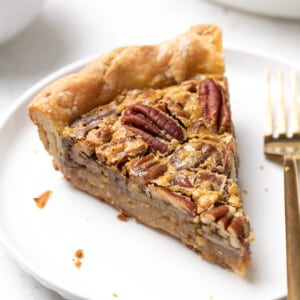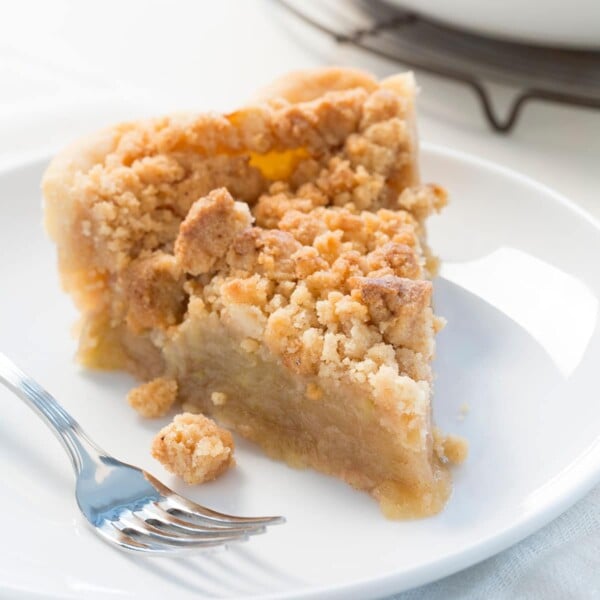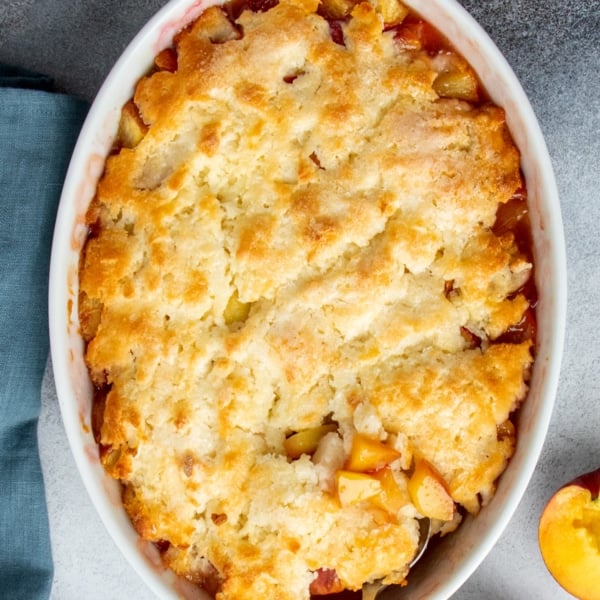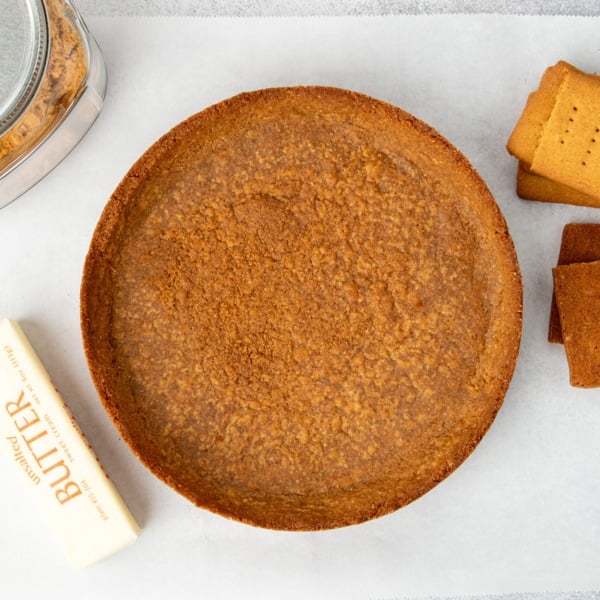This post may contain affiliate links. Please read our disclosure policy.
This classic gluten free pecan pie recipe combines the perfect sweet, salty, and nutty tastes, all in an impossibly flaky gf pie crust that browns and never burns. You won't believe how easy the filling is to make—all without corn syrup!
You may have come looking for a gf pecan pie for the holidays, but you'll find yourself making it all year long. Stash some slices in the freezer and defrost at room temperature for a little treat any time!

Why this recipe works
The star of any gluten free pie, for me, is always an extra flaky gluten free pie crust. And I always start this pie with that perfect recipe for 1 single pie crust—but the simple, mouthwatering filling is what makes this recipe special.
Pecan pie filling is really just a cooked custard made with sugar, butter, and eggs, poured over chopped pecans. But this filling can hold up even without the pecans—and it doesn't call for any corn syrup. Most pecan pie fillings call for 1 full cup of Karo corn syrup.
I don't mind using corn syrup in general, which is designed to prevent sugar crystals from forming, leading to a smoother result. But it makes a different type of pie—and many prefer to avoid using a whole cup of it in a pie.
To help the filling set up stable even without corn syrup, we cook it at a lower temperature and add a bit of superfine white rice flour in the filling mixture. The flour helps the pie set up properly during baking, and keep its shape when it cools.


Expert tips
Don't reduce the sugar in the recipe
This filling recipe has 3 main ingredients: sugar (light brown and granulated), melted butter, and eggs. You can't make it without any of those 3 ingredients.
If you try reducing the sugar at all, you won't just have the less-sweet pie you're going for. You'll have a filling that never sets up and tastes oily and eggy.
Chill the pie crust before rolling
All pastry dough must be cold at all times other than when it's in the oven. Pie crust is no exception.
Pie crust and other pastry dough become crispy and flaky in the oven when there are cold pieces of butter, or another solid fat, that expand in the oven heat. If they're warm when they go into the oven, they'll just melt without expanding.
Experiment with the cooking time
I prefer to bake this pie until the filling is completely set, so it slices very cleanly. If you'd rather have a pie with filling that melts out of the slice a bit, reduce the cooking time by about 10 minutes.
For completely set pie filling, it will resist being pressed in the center when it's done. For a softer filling that's still fully baked, it's done when the filling still jiggles slowly when shaken gently from side to side.
Only slice a chilled pie
Whether your pie is set fully, or set softer, you must wait for it to cool completely before serving. Otherwise, the filling will cave in on itself when you try to slice it.
In fact, I prefer to let it cool completely and then chill in the refrigerator for at least 2 hours before slicing. It's easier to slice, even if you've made a softer filling pie.

Ingredient substitutions
Dairy free
The dairy in the gluten free pie crust can be replaced if you use our recipe for classic gluten free pie crust and follow the instructions under the heading “How to make a gluten free pie crust without sour cream.”
The butter in the filling can be replaced with vegan butter. My favorite brands are Melt and Miyoko's Kitchen.
For the bit of milk, just use your favorite unsweetened unflavored nondairy milk. Any will really do.
Egg free
In place of all 3 eggs, try using 1/4 cup milk at room temperature whisked fully with 2 tablespoons (18 grams) tapioca starch.
Rice flour substitute
You can use sweet white rice flour, also called glutinous rice flour, or tapioca starch. Avoid cornstarch if possible because when it's used to thicken heated fillings, they tend to leak moisture as they cool.
Pecan-free
In place of pecans, try another semi-soft nut like halved walnuts or skinned hazelnuts.
Nut-free
You can make gluten free pecan pie without pecans—or any other nut. The filling is a simple brown sugar custard that's poured over chopped pecans and baked. The pecans on the top do help the custard rise and set evenly on the top, but they're definitely not essential.
Try making the filling without any nuts at all, or try sprinkling some chocolate chips on top of the filling before baking. They should sit right on top of the raw filling, and sink a bit during baking but still hold their shape.

FAQs
Karo brand corn syrup is gluten free unless it's contaminated by something with gluten in it. But we don't need that here.
Yes! You can make the crust recipe weeks ahead of time, and store it in a disk, covered tightly, in the freezer. Defrost and shape before baking.
You can also shape and line your pie pan with the crust, and freeze it as shaped. You won't have to defrost it at all before filling and baking it.
Yes! You can bake, cool, and freeze or refrigerate the whole baked pie quite a few days (in the refrigerator) or weeks (in the freezer) in advance.
I bake pies in a porcelain pie dish or an aluminum pie pan. For best results, avoid a glass pie pan, which retains heat too well and is prone to burning your pie.
Don't take your pie out of the oven when the filling is loose in the pan. It should, at most, jiggle in a very controlled, slow way, when you move the pan from side to side.
Make sure your oven isn't running hot, or cold. Most ovens are off calibration, so I bake using a simple, inexpensive analog oven thermometer—and replace it often. Did you replace or eliminate any filling ingredients? Cut back on the sugar or eggs? Your filling won't set.
Gluten Free Pecan Pie Recipe

Ingredients
For the gf pie crust
- 1 gluten free pie crust, (homemade (linked) or store-bought)
For the filling
- 1 ½ cups (327 g) packed light brown sugar
- 6 tablespoons (75 g) granulated sugar
- 2 tablespoons (1 fluid ounce) milk, at room temperature
- 4 teaspoons pure vanilla extract
- 12 tablespoons (168 g) unsalted butter, melted and cooled slightly
- 3 (150 g (weighed out of shell)) eggs, at room temperature, beaten
- ½ teaspoon kosher salt
- 3 tablespoons (30 g) superfine white rice flour
- 2 cups (180 g) shelled pecan halves, very roughly chopped
For finishing
- ½ cup (60 g) shelled pecan halves, for decorating the top
- Coarse salt, for sprinkling
Instructions
- Prepare the pie crust according to the recipe instructions but without par-baking the crust. Arrange the crust as instructed in a 9-inch deep dish pie crust.
- Place the shaped crust in the pan in the refrigerator to chill for at least 30 minutes, and up to 3 days (if covered).
- When you’re nearly ready to bake the pie, preheat the oven to 325°F.
- In a large bowl, place the brown sugar and granulated sugar, and whisk to combine. Break up any lumps in the brown sugar.
- Add the milk, vanilla, and melted butter, and whisk vigorously until the mixture is very smooth.
- Add the eggs, then the salt and rice flour, and whisk until just combined after each of the two additions.
- Place the chopped pecans in the bottom of the raw, chilled pie crust. Pour the mixture over the pecans in the crust.
- The pecan pieces will rise toward the top on their own.
- Arrange the remaining pecan halves, flat side down, placing them gently on top in concentric circles. Start along the perimeter and work your way in.
- Sprinkle the top of the filling lightly with coarsely salt.
- Place the pie dish pan on a rimmed aluminum baking sheet and in the center of the preheated oven. Bake at 325°F for 20 minutes.
- Lower the oven temperature to 300°F, and bake for another 45 minutes to 1 hour, or until set as you like.
- For a fully set pie, bake it for about 1 hour, or until you can feel that it’s set just below the top pecans when you press the filling gently toward the center.
- For a softer filling that’s still fully baked, bake until the filling still jiggles slowly when shaken gently from side to side, in a controlled way (about another 45 minutes).
- The crust should not burn, as the pie is being baked at such a low oven temperature.
- Let the pie cool to room temperature. For the cleanest slices, place the pie in the refrigerator and chill until firm, at least 3 hours. Slice and serve chilled.
Video
Nutrition
Nutrition information is automatically calculated, so should only be used as an approximation.
Storage instructions
You can make this pecan pie long before you're ready to serve it. You can make and bake the whole pie, then let it cool, cover, and freeze it for at least 3 months.
Just defrost it at room temperature, slicing it once it's cool but not cold. Then, serve the slices still cold or at room temperature.
If you have leftover slices, chill them and wrap them each tightly in freezer-safe wrap. Store them in the refrigerator or the freezer and serve whenever you like!














Made this for Thanksgiving – it is delicious – big hit – will definitely make it again!
So glad you enjoyed the pecan pie, Linda! Thank you for sharing your experience.
Really pleased to have a recipe without corn syrup and with plenty of nuts in the middle of the pie. Thanks for the tip on arranging the nut halves on top; I only had enough to go around the outside and to make a small star in the middle — but it looked good thanks to your tip. The pie set up very nicely as well. Thanks!
I’m so glad to hear it, Jean! You’re so welcome and that sounds lovely, and almost better since a whole top of nuts can be a bit much sometimes!
If I make this in individual ramekins (8 oz each), do I make oven temperature or baking time changes? Thank You – I am SO looking forward to making this recipe – pecan pie is my favorite, but I have a strong (emotional) aversion to corn syrup
Hi, Jody, I hear you on corn syrup. I’m fine with it, but I know that for a lot of people it’s a “page turner” in a cookbook. :) I’m actually not sure, since I’ve never baked it in individual ramekins. Depending on how full you fill the ramekins, you might start at 325°F for 15 minutes and then reduce the oven temperature to 300°F as the recipe states and bake for another 30 minutes, or until it reaches the doneness indicators that I talk about in the recipe card. These are just educated guesses, though!
Thank you so much! Very eager to try these!
You’re very welcome, Jody!
I use maple syrup instead of the sugar or corn syrup. It makes a great pie that is not overly sweet. People I have made it for say how much better it is. Of course it is more expensive but it’s the kind of pie that you wouldn’t eat very often unless you have your own pecan tree.
Any ideas how to make this refined sugar free?
You’d need an entirely different recipe, Sara. I’d recommend a Keto or Paleo blog!
Can you make individual tarts with this filling? Could you use cornflour instead of the rice flour?
Love your recipes.
I discuss substitiutions for the superfine rice flour in the post, Gayle. No, you cannot use cornstarch, if that’s what you mean by “cornflour.” And yes! I think you could make individual tarts.
When you speak about light brown sugar (which I note many of your recipes call for) – do you mean Demerara sugar? Golden Cane Sugar? If not, can I use regular dark brown sugar? These 3 are the only brown sugars we get in Israel.
Hi, Ruth, light brown sugar is granulated sugar with less molasses added to it than dark brown sugar. Demerara sugar has much larger crystals, and it won’t dissolve as well, so I wouldn’t recommend using that. You can either add some molasses to white granulated sugar (if you Google it, there are sites that will tell you how much), or use your dark brown sugar. It’s softer and has more moisture, so it will affect the result, but I don’t know how much since I haven’t tried.
Can you freeze this pie with the pie crust recipe of yours?
Yes, definitely. It freezes well.
Thank you !
Hi Nicole –
Thank You SO much for giving us a corn syrup free pecan pie recipe – priceless and I can’t wait to make it. Quick question for a substitution pretty please – can you substitute tapioca flour, arrowroot flour or ??? for the fine rice flour??? I follow all of your paleo recipes – but I don’t tolerate rice well.
Hi, Debbie, I discuss replacing the rice flour in the post, but recommend my basic gum-free blend or sweet white rice flour. I’m afraid I don’t know if you could successfully replace it with anything else you suggest. I guess you could try arrowroot, but definitely not tapioca alone. You’re out on a bit of a limb with arrowroot, though, since I really just don’t know…